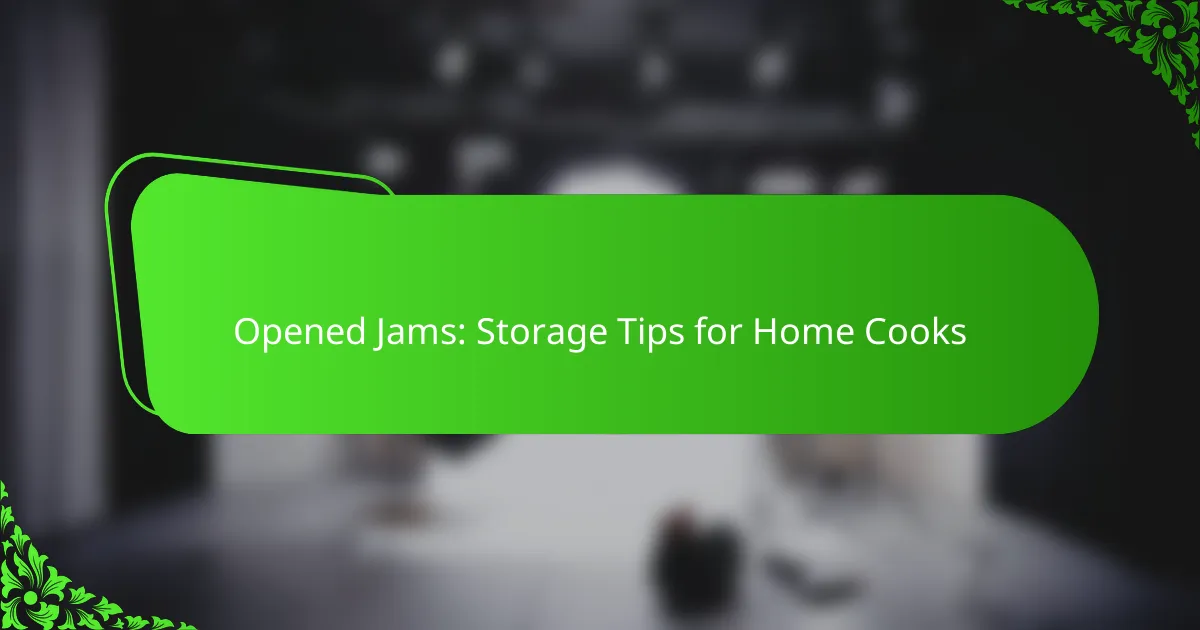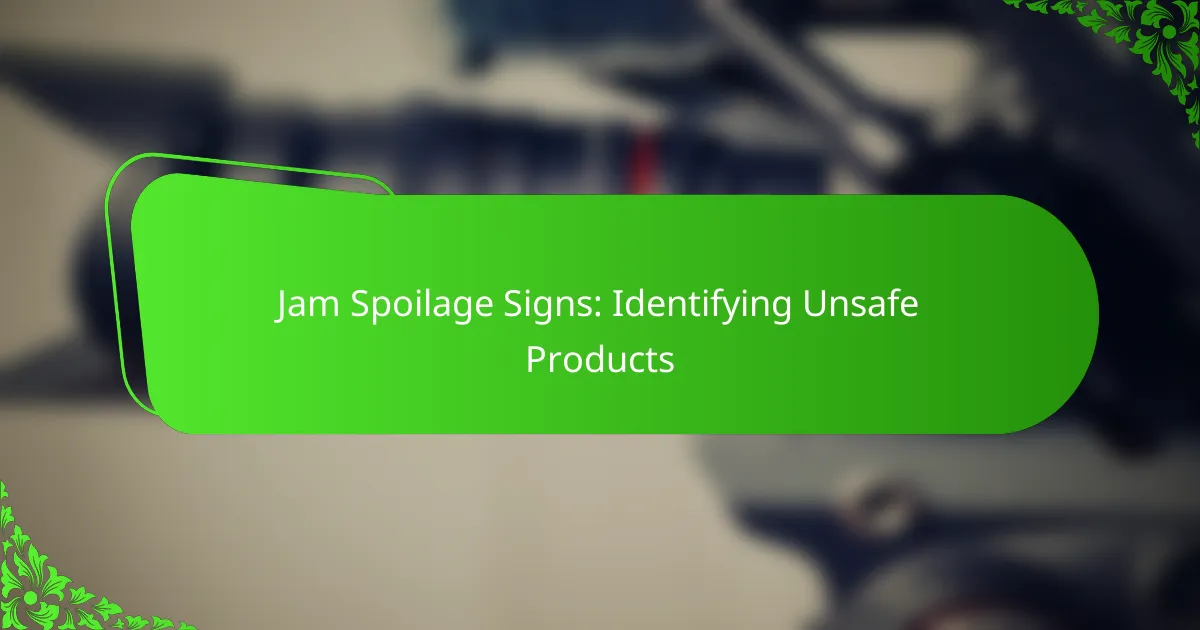Opened jams require careful storage to maintain their freshness and flavor. By keeping them in a cool, dark place and ensuring they are properly sealed, you can extend their shelf life significantly. Glass jars, plastic containers, and vacuum-sealed bags are all effective options for storage, each offering unique benefits. Typically, you can expect opened jams to last in the fridge for one to three months with the right care.

How can you store opened jams effectively?
To store opened jams effectively, keep them in a cool, dark place and ensure they are sealed properly to maintain freshness. Proper storage can significantly extend their shelf life and preserve flavor.
Use airtight containers
Using airtight containers is crucial for preserving the quality of opened jams. Glass jars with tight-fitting lids or plastic containers designed for food storage work well. Avoid using containers that allow air to enter, as this can lead to spoilage.
When transferring jam to a new container, make sure it’s clean and dry to prevent contamination. If the original jar is not resealable, consider investing in high-quality storage options.
Refrigerate immediately
Refrigerating opened jams immediately after use helps slow down the growth of bacteria and mold. Most jams can last for several weeks in the fridge if stored properly. Aim to keep the temperature below 4°C (39°F) to ensure optimal preservation.
Do not leave opened jams at room temperature for extended periods, especially in warm environments, as this increases the risk of spoilage. Always return the jar to the refrigerator promptly after serving.
Label with date
Labeling your opened jams with the date of opening is a simple yet effective practice. This helps you keep track of how long the jam has been stored and when it should be consumed. Use a permanent marker or a label maker for clear visibility.
As a general rule, most opened jams are best consumed within a few weeks to a couple of months. Refer to the label for specific guidance on shelf life and storage recommendations.
Keep away from heat sources
Keeping opened jams away from heat sources is essential for maintaining their quality. Store them in a cool, dark place, ideally in the refrigerator, and avoid placing them near stoves, ovens, or direct sunlight.
Heat can alter the texture and flavor of jams, leading to a less enjoyable experience. Ensure your storage area is consistently cool to prolong the life of your jams.

What are the best types of containers for jam storage?
The best types of containers for jam storage include glass jars, plastic containers, and vacuum-sealed bags. Each option has its own advantages and considerations regarding preservation, ease of use, and longevity.
Glass jars
Glass jars are a popular choice for jam storage due to their airtight seals and ability to withstand high temperatures. They are non-reactive, meaning they won’t alter the flavor of the jam, and are ideal for long-term storage. Ensure that the jars are sterilized before use to prevent spoilage.
When using glass jars, opt for sizes that match your consumption habits. Smaller jars are great for quick use, while larger jars can store more jam for longer periods. Always check the seals for any cracks or damage before filling them.
Plastic containers
Plastic containers offer lightweight and shatterproof alternatives to glass jars. They are convenient for short-term storage and are often available in various sizes. However, not all plastic containers are suitable for long-term preservation, so choose BPA-free options that are designed for food storage.
When using plastic, ensure the lid fits tightly to minimize air exposure. It’s best to consume jam stored in plastic within a few weeks to maintain quality, as they may not provide the same airtight seal as glass jars.
Vacuum-sealed bags
Vacuum-sealed bags are an excellent option for preserving jam by removing air, which helps prevent spoilage and freezer burn. This method is particularly useful if you plan to store jam in the freezer for extended periods. Ensure that the bags are designed for food storage and can withstand freezing temperatures.
To use vacuum-sealed bags, fill them with jam, leaving some space at the top, and use a vacuum sealer to remove the air. This method can significantly extend the shelf life of your jam, allowing you to enjoy homemade flavors long after the season has passed.

How long can opened jams last in the fridge?
Opened jams can typically last in the fridge for about one to three months. Proper storage is essential to maximize their shelf life and maintain quality.
Typically 1-3 months
The general guideline for opened jams is to consume them within one to three months when stored in the refrigerator. This timeframe helps ensure that the jam retains its flavor and texture. Always check for signs of spoilage before use.
To extend the lifespan of your jam, keep it tightly sealed and use a clean utensil each time you scoop some out. This minimizes contamination and helps prevent mold growth.
Depends on sugar content
The sugar content in jams plays a significant role in their longevity. High-sugar jams tend to last longer due to sugar’s natural preservative qualities. Conversely, low-sugar or no-sugar-added varieties may spoil more quickly.
For example, traditional fruit preserves with higher sugar levels can last closer to three months, while lighter fruit spreads may only remain good for a month. Always read labels for specific storage recommendations related to sugar content.

What are common signs of spoilage in jams?
Common signs of spoilage in jams include mold growth, off smells, and changes in color. Recognizing these indicators can help you determine whether your opened jam is still safe to consume or should be discarded.
Mold growth
Mold growth is one of the most visible signs of spoilage in jams. If you notice any fuzzy or discolored patches on the surface, it’s best to discard the jam entirely, as mold can penetrate deeper than it appears. Even if you scrape off the mold, harmful bacteria may still be present.
To prevent mold, always use clean utensils when scooping out jam and ensure the jar is tightly sealed after each use. Store opened jams in the refrigerator to slow down mold development.
Off smell
An off smell is a clear indication that your jam may have spoiled. Fresh jam should have a sweet, fruity aroma, while spoiled jam may emit a sour or fermented scent. If the smell is unpleasant, it’s safer to throw the jam away.
Regularly check the aroma of your jam, especially if it has been open for several weeks. If you’re unsure, trust your nose; it’s a reliable guide for freshness.
Change in color
A change in color can signal spoilage in jams. If you notice that your jam has darkened significantly or developed unusual hues, it may no longer be safe to eat. This can occur due to oxidation or the growth of bacteria.
To maintain the color and quality of your jam, store it in a cool, dark place and keep it tightly sealed. If you see any discoloration, it’s wise to err on the side of caution and discard the jam.

What are the best practices for jam storage in warm climates?
In warm climates, the best practices for jam storage include keeping the jam refrigerated and minimizing exposure to humidity. These steps help preserve flavor and prevent spoilage, ensuring your homemade jams remain safe and delicious for longer periods.
Use refrigeration
Refrigeration is essential for storing opened jams in warm climates. Keeping jam in the fridge slows down the growth of bacteria and mold, which thrive in warmer temperatures. Aim to store your jam at temperatures below 4°C (39°F) for optimal freshness.
After opening, consume the jam within a few weeks to a couple of months, depending on the ingredients. Always use a clean spoon to avoid introducing contaminants, which can shorten the shelf life.
Avoid humidity
Humidity can lead to spoilage and mold growth in opened jams. Store your jam in a cool, dry place, away from moisture sources like dishwashers or sinks. If possible, keep the jar tightly sealed to limit exposure to humid air.
Consider using silica gel packets in your pantry to absorb excess moisture. If you notice any signs of mold or off smells, it’s best to discard the jam to ensure food safety.










